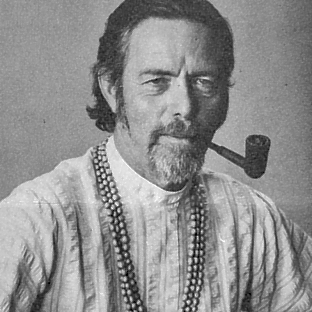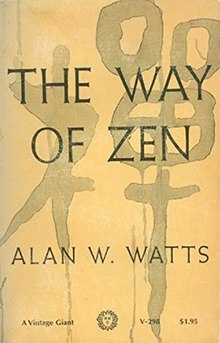
The Tao is the natural way of the universe, whose character one's intuition must discern to realize the potential for individual wisdom, as conceived in the context of East Asian philosophy, religion, and related traditions. This seeing of life cannot be grasped as a concept. Rather, it is seen through actual living experience of one's everyday being. Its name, "Tao", or "Dao" , came from Chinese, where it signifies the way, path, route, road, or sometimes more loosely doctrine, principle, or holistic belief.
Eastern philosophy or Asian philosophy includes the various philosophies that originated in East and South Asia, including Chinese philosophy, Japanese philosophy, Korean philosophy, and Vietnamese philosophy; which are dominant in East Asia, and Indian philosophy, which are dominant in South Asia, Southeast Asia, Tibet, and Mongolia.

Alan Wilson Watts was an English writer, speaker, and self-styled "philosophical entertainer", known for interpreting and popularising Buddhist, Taoist, and Hindu philosophy for a Western audience.
Satori (悟り) is a Japanese Buddhist term for awakening, "comprehension; understanding". It is derived from the Japanese verb satoru.

The Kyoto School is the name given to the Japanese philosophical movement centered at Kyoto University that assimilated Western philosophy and religious ideas and used them to reformulate religious and moral insights unique to the East Asian philosophical tradition. However, it is also used to describe postwar scholars who have taught at the same university, been influenced by the foundational thinkers of Kyoto school philosophy, and who have developed distinctive theories of Japanese uniqueness. To disambiguate the term, therefore, thinkers and writers covered by this second sense appear under The Kyoto University Research Centre for the Cultural Sciences.
Nondualism includes a number of philosophical and spiritual traditions that emphasize the absence of fundamental duality or separation in existence. This viewpoint questions the boundaries conventionally imposed between self and other, mind and body, observer and observed, and other dichotomies that shape our perception of reality. As a field of study, nondualism delves into the concept of nonduality and the state of nondual awareness, encompassing a diverse array of interpretations across traditions, not limited to a particular cultural or religious context; instead, nondualism emerges as a central teaching across various traditions, inviting individuals to examine reality beyond the confines of dualistic thinking.

Daisetsu Teitaro Suzuki, self-rendered in 1894 as "Daisetz", was a Japanese essayist, philosopher, religious scholar, translator, and writer. He was a scholar and author of books and essays on Buddhism, Zen and Shin that were instrumental in spreading interest in both Zen and Shin to the West. Suzuki was also a prolific translator of Chinese, Japanese, and Sanskrit literature. Suzuki spent several lengthy stretches teaching or lecturing at Western universities, and devoted many years to a professorship at Ōtani University, a Japanese Buddhist school.

Travers Christmas Humphreys, QC was a British barrister who prosecuted several controversial cases in the 1940s and 1950s, and who later became a judge at the Old Bailey. He also wrote a number of works on Mahayana Buddhism and in his day was the best-known British convert to Buddhism. In 1924 he founded what became the London Buddhist Society, which was to have a seminal influence on the growth of the Buddhist tradition in Britain. His former home in St John's Wood, London, is now a Buddhist temple. He was an enthusiastic proponent of the Oxfordian theory of Shakespeare authorship.

Reginald Horace Blyth was an English writer and devotee of Japanese culture. He is most famous for his writings on Zen and on haiku poetry.

Japanese Zen refers to the Japanese forms of Zen Buddhism, an originally Chinese Mahāyāna school of Buddhism that strongly emphasizes dhyāna, the meditative training of awareness and equanimity. This practice, according to Zen proponents, gives insight into one's true nature, or the emptiness of inherent existence, which opens the way to a liberated way of living.

Sokei-an Shigetsu Sasaki, born Yeita Sasaki, was a Japanese Rinzai monk who founded the Buddhist Society of America in New York City in 1930. Influential in the growth of Zen Buddhism in the United States, Sokei-an was one of the first Japanese masters to live and teach in America and the foremost purveyor in the U.S. of Direct Transmission. In 1944 he married American Ruth Fuller Everett. He died in May 1945 without leaving behind a Dharma heir. One of his better known students was Alan Watts, who studied under him briefly. Watts was a student of Sokei-an in the late 1930s.

In the study of comparative religion, the East Asian religions or Taoic religions, form a subset of the Eastern religions. This group includes Chinese religion overall, which further includes Ancestral Worship, Chinese folk religion, Confucianism, Taoism and popular salvationist organisations, as well as elements drawn from Mahayana Buddhism that form the core of Chinese and East Asian Buddhism at large. The group also includes Japanese Shinto, Tenrikyo, and Korean Muism, all of which combine Shamanistic elements and indigenous ancestral worship with various influences from Chinese religions. Chinese salvationist religions have influenced the rise of Japanese new religions such Tenriism and Korean Jeungsanism; as these new religious movements draw upon indigenous traditions but are heavily influenced by Chinese philosophy and theology.

Buddhism includes an analysis of human psychology, emotion, cognition, behavior and motivation along with therapeutic practices. Buddhist psychology is embedded within the greater Buddhist ethical and philosophical system, and its psychological terminology is colored by ethical overtones. Buddhist psychology has two therapeutic goals: the healthy and virtuous life of a householder and the ultimate goal of nirvana, the total cessation of dissatisfaction and suffering (dukkha).
Buddhist modernism are new movements based on modern era reinterpretations of Buddhism. David McMahan states that modernism in Buddhism is similar to those found in other religions. The sources of influences have variously been an engagement of Buddhist communities and teachers with the new cultures and methodologies such as "Western monotheism; rationalism and scientific naturalism; and Romantic expressivism". The influence of monotheism has been the internalization of Buddhist gods to make it acceptable in modern Western society, while scientific naturalism and romanticism has influenced the emphasis on current life, empirical defense, reason, psychological and health benefits.

Enlightenment is a concept found in several religions, including Buddhist terms and concepts, most notably bodhi, kensho, and satori. It represents kaivalya and moksha (liberation) in Hinduism, Kevala Jnana in Jainism, and ushta in Zoroastrianism.
Zen is a school of Mahayana Buddhism that originated in China during the Tang dynasty as the Chan School or the Buddha-mind school ," and later developed into various sub-schools and branches. From China, Chán spread south to Vietnam and became Vietnamese Thiền, northeast to Korea to become Seon Buddhism, and east to Japan, becoming Japanese Zen.
Secular Buddhism—sometimes also referred to as agnostic Buddhism, Buddhist agnosticism, ignostic Buddhism, atheistic Buddhism, pragmatic Buddhism, Buddhist atheism, or Buddhist secularism—is a broad term for a form of Buddhism based on humanist, skeptical, and agnostic values, valuing pragmatism and (often) naturalism, eschewing beliefs in the supernatural or paranormal. It can be described as the embrace of Buddhist rituals and philosophy for their secular benefits by people who are atheist or agnostic.
Modern scientific research on the history of Zen discerns three main narratives concerning Zen, its history and its teachings: Traditional Zen Narrative (TZN), Buddhist Modernism (BM), Historical and Cultural Criticism (HCC). An external narrative is Nondualism, which claims Zen to be a token of a universal nondualist essence of religions.
Buddhist thought and Western philosophy include several parallels.
The Zen boom was a rise in interest in Zen practices in North America, Europe, and elsewhere around the world beginning in the 1950s and continuing into the 1970s. Zen was seen as an alluring philosophical practice that acted as a tranquilizing agent against the memory of World War II, active Cold War conflicts, nuclear anxieties, and other social injustices. The inception of the surge in interest is largely responsible for lectures on Zen by D.T. Suzuki at Columbia University from 1950 to 1958, as well as his many books on the subject. Authors like Ruth Fuller Sasaki and Gary Snyder also traveled to Japan to formally study Zen Buddhism. Snyder would influence fellow Beat poets from Allen Ginsberg, and Jack Kerouac, to Philip Whalen, to also follow his interest in Zen. Alan Watts also published his classic book The Way of Zen as a guide to Zen intended for western audiences.











